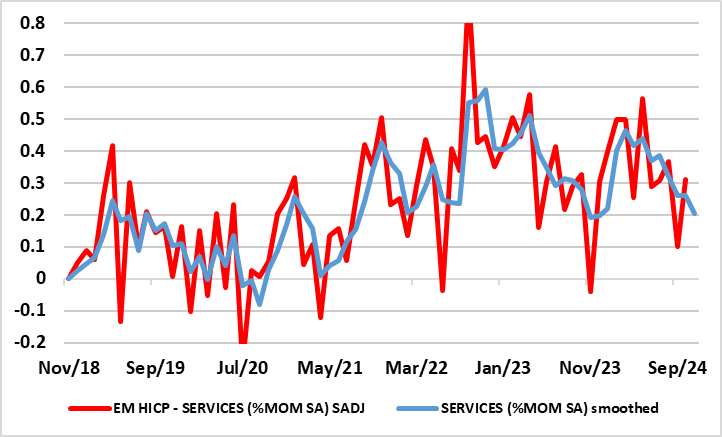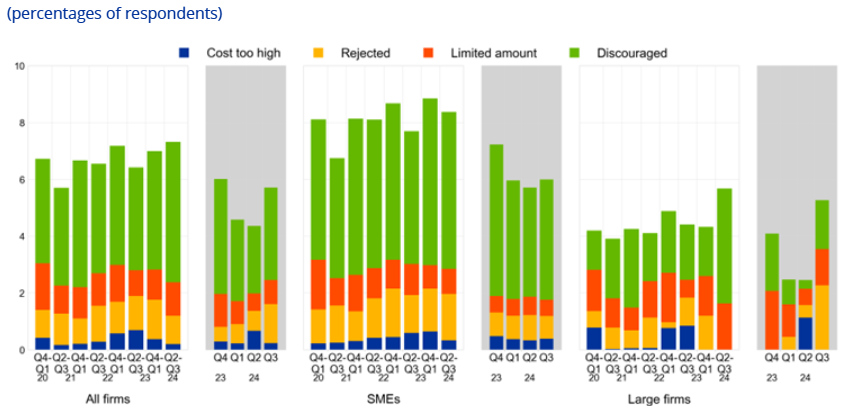ECB October Meeting Account: It’s the (Real) Economy Stupid!
It is clear but hardly surprising that the ECB rate cut last month was driven as much, if not more by real economy consideration than prices or possible fiscal tightening. The Oct account 16-17 suggested that the downside risks to the growth outlook in the September baseline, with the associated weakening of inflation pressures, had become more prominent and this was the basis of the further rate cut, very much described as ‘prudent risk management’. Even so, it is clear that the inflation picture had become more reassuring, both from recent data downside surprises but also on forward-looking indicators even in regard less-resilient services (Figure 1), all of which hinted at inflation hitting the 2% target on a sustained basis sooner than previous expected. The Bank Lending Survey had offed some brighter signs at least for households; but growth in lending to firms and demand for bank loans by firms remained weak something backed up by firms themselves which still highlight obstacles to bank credit (Figure 2). Indeed, the ECB may be perturbed by its own surveys. Despite having cut rates three times, these surveys suggest that the effects of past monetary policy tightening continued to raise borrowing costs, and that firms perceived the general economic outlook to be the main factor hampering the availability.
Overall, there are still abundant inconsistencies in ECB thinking. The account noted that the inflation outlook had been affected by recent downside surprises in real economic activity, but that the weaker growth outlook primarily reflected structural rather than cyclical demand factors, ie outside the realm of monetary policy. If so, it is hard to fathom why the ECB seems so willing to take the credit for inflation having moved back to target earlier than it had hoped or expected, when it is likely supply and structural factors that have been at work!
Figure 1: Is the ECB Belatedly Waking Up to Softer Service Price Signals?

Source: ECB, Eurostat, CE, smoothed = 3 mth chg
Price Indicators Moving in the Right Direction
The lower than expected HICP inflation backdrop largely reflected downside surprises in goods inflation and – to a lesser degree – services inflation and underlying inflation indicators had eased or were stable. Notably, month-on-month seasonally adjusted services inflation rates for August and September were closer to the long-term average, suggesting a moderation in inflation dynamics compared with earlier in the year, something we have been emphasizing and we think will have continued (Figure 1). Indeed, the ECB seems more confident that services inflation will decelerate as the current y/y rate has been clearly boosted by backward-looking elements and one-off factors such as insurance fees. This softer services outlook was backed up by signals for wage growth in 2025 which were either in line with or below the September projections and where survey indicators also suggested a marked deceleration in wage growth in the coming year. Overall, though, it was noted that the outcome for headline inflation in September 2024 would imply a lower inflation path than had been expected in the September staff projections and therefore signalled a downside risk in which the 2% target could be reached earlier in 2025
The Bank Lending Survey had offed some brighter signs at least for households; lower interest rates and better housing market prospects had led to a strong increase in the demand for mortgages. But growth in lending to firms and demand for bank loans by firms remained weak and credit standards for loans to firms had remained at the restrictive levels reached after more than two years of progressive tightening. This is backed up by firms themselves.
Figure 2: Firms Say Obstacles to Obtaining a Bank Loan Remain Sizeable

Source: ECB. Financing obstacles are defined here as the total of the percentages of enterprises reporting (i) loan applications that resulted in an offer that was declined by the enterprise because the borrowing costs were too high, (ii) loan applications that were rejected, (iii) a decision not to apply for a loan for fear of rejection (discouraged borrowers), and (iv) loan applications for which only a limited amount was granted. The grey areas represent responses to the same question within a reference period of three months
Firms Still Cautious on Outlook
We have put much emphasis in the past on the important messages to be gleaned from bank lending surveys in terms of the cost and supply of credit. But this of course is purely from the perspective of banks. In this regard, the ECB survey on access to finance by enterprises offers the perspective from firms themselves and the latest results (for Q3 and published in the last week) are certainly still interesting and a clear cause for continued concern from the ECB. Overall, the survey results suggest that the effects of past monetary policy tightening have continued to raise borrowing costs, albeit to a much lesser extent than in the second quarter. Moreover, many firms indicated a further tightening of other loan conditions and still almost no changes in bank loan availability. Perhaps most notable was that firms perceived the general economic outlook to be the main factor hampering the availability of external financing and to a greater extent than in the previous survey round, but where obstacles to obtaining bank loans were both still elevated and in some cases higher (Figure 2).
Otherwise, there was little sign that fiscal tightening risks were a growing concern. Instead, concern was expressed that the multi-year nature of the plans and the focus on the years ahead could leave 2024 as a year with still excessive fiscal spending.